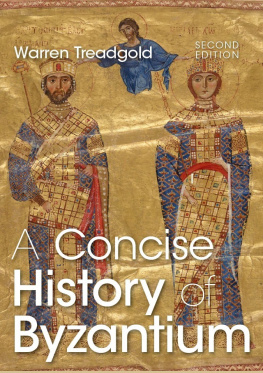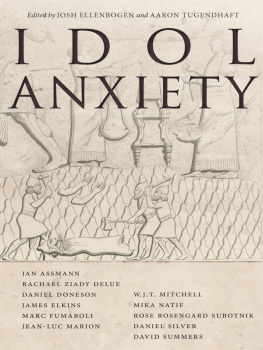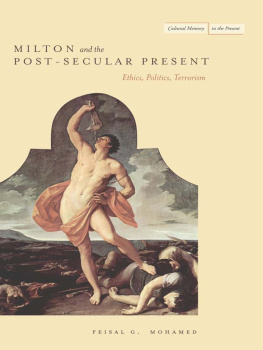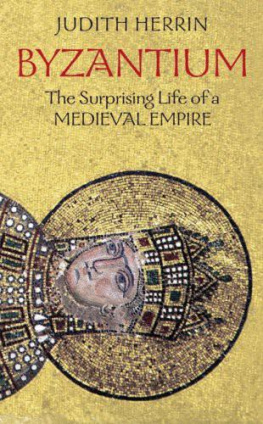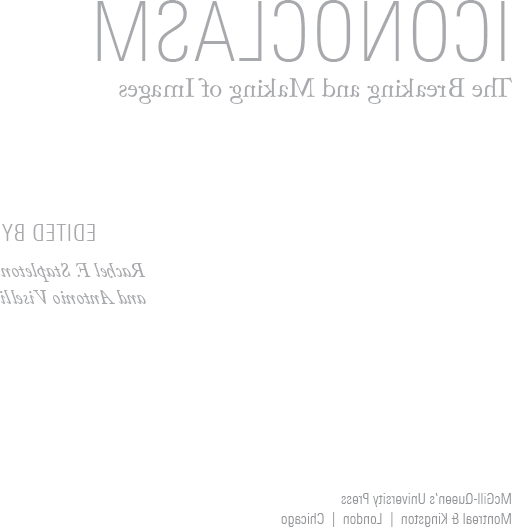

ICONOCLASM
The Breaking and Making of Images
EDITED BY
Rachel F. Stapleton
and Antonio Viselli
McGill-Queens University Press
Montreal & Kingston | London | Chicago
McGill-Queens University Press 2019
ISBN 978-0-7735-5736-9 (cloth)
ISBN 978-0-7735-5737-6 (paper)
ISBN 978-0-7735-5838-0 (ePDF)
ISBN 978-0-7735-5839-7 (ePUB)
Legal deposit third quarter 2019
Bibliothque nationale du Qubec
Printed in Canada on acid-free paper that is 100% ancient forest free (100% post-consumer recycled), processed chlorine free
We acknowledge the support of the Canada Council for the Arts.
Nous remercions le Conseil des arts du Canada de son soutien.
Library and Archives Canada Cataloguing in Publication
Title: Iconoclasm : the breaking and making of images / edited by Rachel F. Stapleton and Antonio Viselli.
Other titles: Iconoclasm (2019)
Names: Stapleton, Rachel F., 1981 editor. | Viselli, Antonio, 1985 editor.
Description: Includes bibliographical references and index.
Identifiers: Canadiana (print) 20190104074 | Canadiana (ebook) 20190104104 | ISBN 9780773557376 (paper) | ISBN 9780773557369 (cloth) | ISBN 9780773558380 (ePDF) | ISBN 9780773558397 (ePUB)
Subjects: LCSH: AestheticsCase studies. | LCSH: Image (Philosophy)Case studies. | LCSH: IconoclasmCase studies. | LCSH: IconsCase studies. | LCGFT: Case studies.
Classification: LCC BH301.I52 I36 2019 | DDC 701/.03dc23
Set in 10.5/14 Adobe Caslon Pro with Univers Next Pro
Book design & typesetting by Garet Markvoort, zijn digital
to our families
R.F.S. & A.V.
CONTENTS
RACHEL F. STAPLETON & ANTONIO VISELLI
MICHAEL TAUSSIG
RACHEL F. STAPLETON & ANTONIO VISELLI
CHRISTOPHER VAN GINHOVEN REY
BETH SAUNDERS
NATALIE PENDERGAST
EMILY HOFFMAN
BRENDON WOCKE
RACHEL F. STAPLETON & ANTONIO VISELLI
T. NIKKI CESARE SCHOTZKO
ADAM SWANN
RACHEL F. STAPLETON & ANTONIO VISELLI
ANGELA TOSCANO
HELEN HESTER
FIGURES
ACKNOWLEDGMENTS
This volume arises from papers presented at the conference Iconoclasm: The Breaking and Making of Images, which took place at the Centre for Comparative Literature at the University of Toronto, 1719 March 2011. The conference committee of then graduate students worked tirelessly for almost a year to put together an international conference with plenary lectures by Carol Mavor (University of Manchester), Michael Taussig (Columbia University), and Eric Cazdyn (University of Toronto), and featuring more than forty papers by scholars from around the globe.
The 22nd Annual Conference of the Centre for Comparative Literature was organized by Olga Bazilevica, Natalie Pendergast, Jeannine M. Pitas, Rachel F. Stapleton, Kristina Syvarth, and Antonio Viselli, with assistance from Jonathan A. Allan, and with the unwavering support of the Centre: Neil ten Kortenaar, who was our sounding board from writing the CFP to preparing this volume; Linda Hutcheon, who sponsored and supported our successful Social Sciences and Humanities Research Council of Canada grant; Ann Komaromi, who supported the latter phases of this publication; Aphrodite Gardner, whose administrative wizardry kept us on track and on budget; and Bao Nguyen, whose design acumen made for a visually impressive conference.
Of course, any conference, and subsequent volume, is only as good as its participants, and so we gratefully acknowledge all the participants who attended the University of Toronto on that March weekend, and particularly Christopher van Ginhoven Rey, Beth Saunders, Emily Hoffman, Brendon Wocke, T. Nikki Cesare Schotzko, Adam Swann, Angela Toscano, and Helen Hester, who have worked with us over the intervening years with exemplary patience as we brought this volume to fruition. We also offer our thanks to the two reviewers whose generous comments helped shape this volume. And finally, wed like to thank Jonathan Crago and the staff at MQUP for their work in making this book possible.
Rachel F. Stapleton and Antonio Viselli

RACHEL F. STAPLETON & ANTONIO VISELLI
INTRODUCTION
If Its Broke, Dont Fix It: The Back-to-Front Logic of Iconoclasm
Make or Break
All icons have their limits, their breaking points. In Iconoclasm: The Breaking and Making of Images, we explore this threshold by examining the how and the what of symbolic and material images, and the many ways these venerated and despised images often exceed or transgress themselves, especially when they are broken, altered, or recontextualized.
A recurring concept that unites the chapters in this work is what Michael Taussig identifies in The destructive act now metonymically stands in place of the once sacred object: transgression is now the idol.
Before unpacking the various definitions of iconoclasm and how they relate to what this volume recognizes as conceptual iconoclasm, let us illustrate a fairly recent example of this back-to-front logic at play, one which demonstrates how current and pervasive instances of iconoclasm are, instances that merit critical attention now more than ever.
On 7 January 2015, two gunmen entered the offices of Charlie Hebdo, a satirical newspaper in Paris, and opened fire, killing twelve people and injuring several others. The attackers were two brothers, Sad and Chrif Kouachi, who identified with Al-Qaeda, and who killed the cartoonists and staff as revenge for the satirical portrayal in a cartoon of the prophet Muhammad. This case demonstrates the Taussigian principle in action, since iconoclasts on each side both satirists and terrorists have bestowed iconic status on what they meant to desecrate. As a publication, Charlie Hebdo is now both iconic and iconoclastic: its front cover is immediately recognizable and carries with it an aura of provocation, subversion, and shock value from the masthead down. Such provocation, following the attacks, was quickly converted into sales: the first issue published after the shooting saw a record number of sales domestically and internationally, as the issue was also translated into several other languages. Yet, it is the content of the magazine that underlines its iconoclastic tendencies, content that tends toward the sacrilegious and the blasphemous, in particular its offensive portrayals of the prophet Muhammad; it dismantles, via ridicule, individuals and ideologies, from the politically relevant to anything (everything) considered sacred.
Not unlike the Danish Jyllands-Posten cartoon controversy in 2005, Charlie Hebdos continuous representations of the prophet Muhammad a representational act considered sacrilegious within many aniconist Islamic traditions were an instigating element that led to the massacre of the cartoonists and their staff. This violent, iconoclastic act is at once direct, metaphoric, and metonymic. To destroy, tear up, or burn an issue of Charlie Hebdo is one matter, but to spill more blood than ink by massacring the hands behind the satirical drawings pushes the purification and punishment of the iconoclastic act from the image beyond its pages. In interrogating iconoclasms, iconoclashes, and iconocrises, Bruno Latour demands that we do not ignore the hand at work in creating icons; the
Next page

